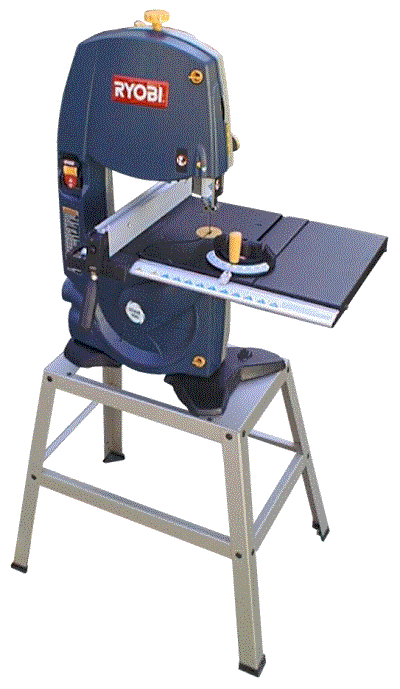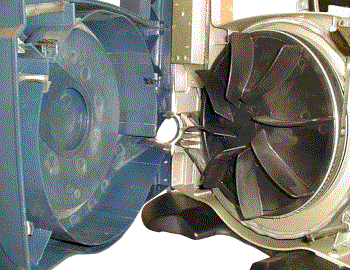|
|
|
| Description The Ryobi BS1001 bandsaw is a small, feature rich machine just a little bit larger than a benchtop unit. It has a 10" throat and 4" resaw height capacity. The unit comes with a stand, two blades, a rip fence, and miter gauge. One of the major new features on the machine is the integral dust collection system. The machine also has built-in work lights, an expandable table, and a quick de-tensioning lever. The frame of the machine is a powder coated aluminum casting which seems to be fairly strong. It has a single piece plastic cover that swings open for blade changes. The cover is latched with two large dzus fasteners and mates with the frame very well. The machine rests on a heavy cast base that is bolted to the stand. It's ODP, 8 amp induction motor will make it about 1.2 horsepower and is fairly quiet. The motor is directly bolted to the frame. Power is transferred to the wheel through a single cogged belt using two cogged plastic drive wheels. Assembly |
 |
|
Click to enlarge |
Features I mentioned that the BS1001 is "feature rich". What I mean by that is the machine has several features that have been integrated into the design, these features are usually not included on machines costing quite a bit more. There are two sets of LED work lights on the machine, one set spotlights the cutting area and the other illuminates the blade riding on the top wheel through a window in the case. These are turned on via a switch in the plastic cover. The expanding table is large with more area than typically found
on larger, more costly machines. I did find that the table was somewhat easy to
tweak out of it's locked in angle. In looking at the mechanism it appears that the
locking knob just cannot apply enough force to keep it in position; the steel section of
the trunion also deflects under load. This is an issue that needs to be addressed
one way or another. |
The main table is an aluminum casting. The steel extension section can also be moved out several inches to expand the table further, this is locked in place with a small knob under the table. The miter gauge slot is small, exactly what you would expect on a machine this size. The rip fence on the other hand is larger than one might expect, it is quite similar to the BT3100 fence and locks on both the front rail and rear edge of the table. |
The trunion is basically an aluminum casting with a gear and locking knob use to set the angle. Attached to the trunion is a formed steel bracket used to support the table on the infeed side. The table is bolted to the trunion with four flathead bolts and is quick and easy to remove if needed. Note also the removed side cover showing the drive wheel. |
| Dust Collection One of the main marketed features of the machine is what Ryobi calls the "Silent Vac" system. What they have done here is attach a blower to the lower wheel and use this to draw air and chips from the cutting area and exhausting to a collection bag. Formed into the frame and the plastic cover is a chamber that directs all of this appropriately. You might think that this would add some significant noise to the machine but my general impression is that the BS1001 is a quiet machine. If you remove the dust bag it is obvious that the Silent Vac system is working, you can see the chips spread on the floor. If you use the machine for a period of time and open the side cover, you can tell also that it isn't getting 100% of the chips, there is some accumulation in various nooks and crannies. I would guess that the system is getting well over 90% of the chips though. The exhaust port will also accommodate a standard shopvac hose.. My general impression of the Silent Vac system is that it works far better than any bandsaw I've used with an active dust collection hookup; if active collection is used, the dust collection is VERY good. |
 |
| In Use Performance wise, the BS1001 seems to have enough power and precision for the tasks it is likely to be asked of it. While I would not expect it to be a resaw master I did resaw some 3" tall Hard Maple. Although it was slow going, it did perform the task. I will stress though that when re-sawing, the feed rate is critical. If the feed rate is too high, the angle will be off or the cut will have a bow in it. Even though I wouldn't want to do a lot of resaw work on the machine, this sort of operation should be expected of any bandsaw. For instance when cutting tenons this actually is the operation being performed. I did a sample tenon cut with the saw using the wider blade supplied. In this test I found that I was able to cut a tenon with thickness dimensions within 0.003" (which is quite respectable). The key here (I want to stress again) is to use the proper feed rate. One reason "I" wouldn't resaw on the BS1001 is because I already have a 3hp monster bandsaw for that. A natural question may arise, "what would you want with a small bandsaw if you have a big one?". For one, although a big bandsaw is good at applications requiring a lot of power, they are not particularly suited for fine work nor are they particularly precise, the BS1001 bridges this performance gap. Blade changes proved to be a non-event, you'll probably spend more time removing and replacing the table bolt than you will putting the blade on. There is some vibration evident in the table when the machine is on. I'm not sure what the cause of this is. |
| Summary The only issue I have with the BS1001 is the flex and angle setting of the table (which needs to be addressed). Aside from that, the thing that keeps coming back to me on the BS1001 is that in addition to just a basic, small bandsaw, Ryobi has designed in several beneficial features while still keeping the price down. The Silent Vac is such a simple and effective concept it really makes you wonder why no one (to my knowledge) has ever done this before. In addition, the detensioning lever, integral work lights, and expanding table are all simple improvements that could easily and (I think) SHOULD be found on more expensive bandsaws. This 3hp bandsaw I mentioned earlier cost nearly ten times more than the BS1001 and it has NONE of these features! |
In the interest of full disclosure Ryobi provided this product to facilitate this review. |